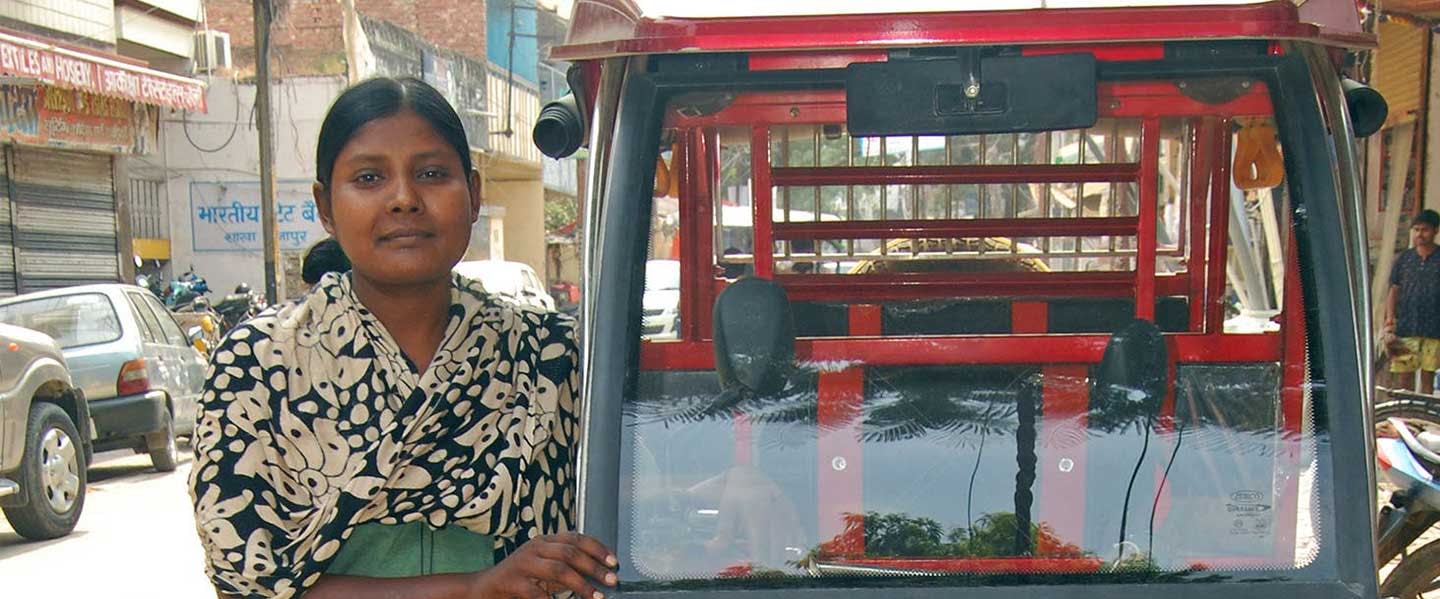Electric rickshaws offer a climate-friendly way to roll in Varanasi
Jugnu Prasad maneuvers silently through congested streets in Varanasi, India. While the city is engulfed in heavy air pollution and the cackling noise of fossil fuel-powered transportation, Prasad’s ride does not leave a trail of fumes behind, and runs quietly.
The 40-year-old former rickshaw puller is now driving a three-wheel electric rickshaw that he purchased on loan with help from social venture SMV Green Solutions.
The Varanasi-based company provides a safe and affordable transport alternative for last-mile mobility, or the last leg in a passenger’s journey, usually delivered by polluting buses and auto-rickshaws. SMV operates in two of the country’s most populous states--Uttar Pradesh and Bihar--where it provides support and guidance to people from low-income groups to purchase electric rickshaws.
In 2015, Naveen Krishna founded the company with the intention of eliminating the drudgery faced by manual rickshaw pullers, prevalent in northern India.
Knowing that it wouldn't be easy for them to upgrade to an electric vehicle (EV) themselves due to lack of access to funding and the confidence to try a new technology, the company established connections with multiple entities to streamline the process of procuring a ready-to-drive e-rickshaw. “We are a bridge connecting the person to an e-rickshaw manufacturer, financial institution sanctioning loans that banks won’t normally give to low-income groups, battery providers, and authorities to complete the paperwork,” Prasad said.
The company’s mission is in line with the state government’s objective of achieving 100% electrification of auto-rickshaws in Varanasi and other cities by 2030. Krishna said,
A recent survey showed that six of the world’s most polluted cities in terms of PM2.5 --particulate matter in the air that are too small to lodge directly in the lungs when breathed in--were in Uttar Pradesh and three were from Bihar. Varanasi ranked 14th in the list. Particulate matters and polluting gases from automobile emissions contribute to making breathing the air in the city a death sentence.
The transport sector is also one of India’s highest greenhouse gases emitters, with estimated emissions of about 312.3 million tonnes of carbon dioxide equivalent (MtCO2e) per annum. Greenhouse gases trap heat in the atmosphere, make the earth warmer, and induce climate change.
Sugandha Pal, an urban transport planner and a research associate at The Energy and Research Institute (TERI) who studied auto-rickshaw emissions in Bengaluru, said “7.5% of total emissions in India are from the transport and automotive sector.”
Citing TERI’s estimates, she added, “Three-wheelers could increase from 6.8 million in 2017-18 to 19.5 million in 2030 and further to 66.25 million in 2050, which provides scope for leapfrogging towards e-rickshaws and replacing the conventional three-wheelers.”
SMV has enabled 1038 e-rickshaw ownerships, of which 550 are in Varanasi. The social enterprise that has been nominated in 2019 Ashden Awards under the International Sustainable Mobility category, estimates that it has reduced 2076 tonnes of CO2 emissions since its inception.
Krishna’s wish is to see his homeland less polluted and ensure that his children don’t have to “roam around with oxygen tanks.”
But the electrification of India’s transport sector is a bumpy ride. Considering e-rickshaws, Krishna feels that the price and taxes on lithium-ion batteries, the charging infrastructure, and the commercial rate of electricity per unit are the biggest hurdles.
To tackle the issue, SMV has established two battery swapping stations in Varanasi with a capacity to charge 15 batteries at a time. The drivers can exchange their drained batteries with a fully charged one for Rs.200 ($2.88) and get back to business within minutes. Krishna is convinced that in his region, swapping stations are the best option for an e-mobility infrastructure.
SMV currently employs 55 people and has shifted gears to a self-sustaining model. The enterprise earns its share through margins from vehicle dealers, battery charging service, and selling spare parts.
In 2017, SMV launched the Vahini program to enable women to own an e-rickshaw and earn a livelihood. “Vahini provides dignified jobs to women and safe, affordable transport for female passengers and children,” explained Krishna. “Freedom of mobility is empowerment,” he said.
At present, Krishna is driving e-rickshaw expansion in other key cities in Uttar Pradesh and Bihar. He is also considering entering into rural area electrification using clean energy sources.
“If there’s a new clean technology available tomorrow, we’ll adapt to that and enable an ecosystem around it,” he said.



